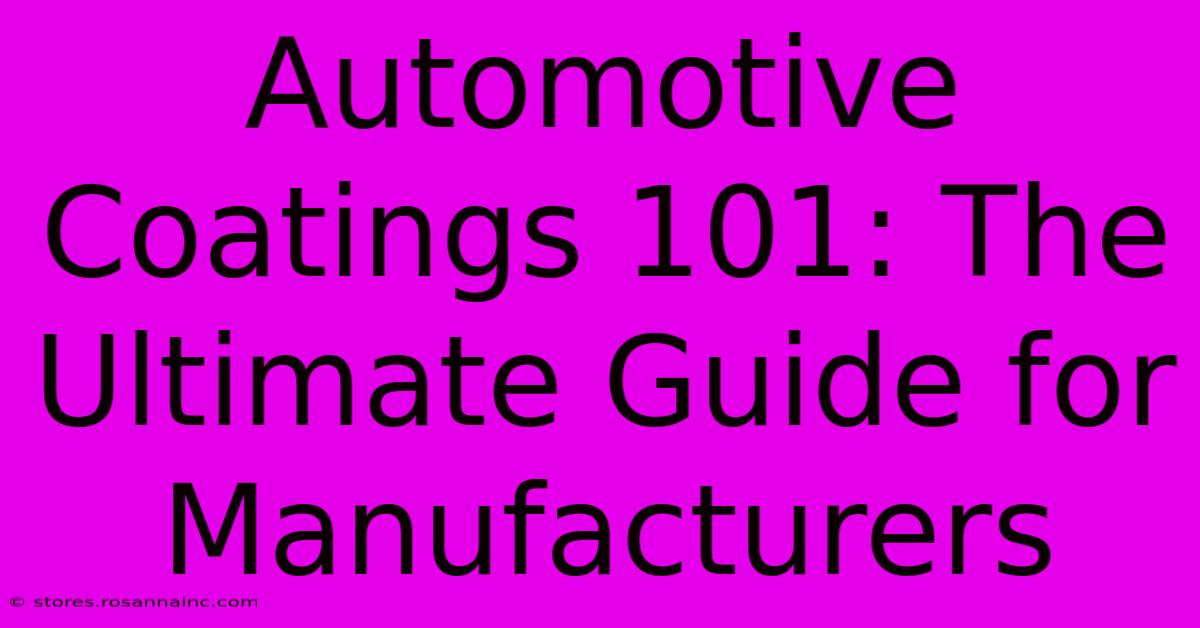Automotive Coatings 101: The Ultimate Guide For Manufacturers

Table of Contents
Automotive Coatings 101: The Ultimate Guide for Manufacturers
The automotive industry is a demanding landscape, constantly pushing the boundaries of innovation. At the heart of a vehicle's appeal and longevity lies its finish – the protective and aesthetically pleasing automotive coating. This guide provides manufacturers with a comprehensive understanding of automotive coatings, their types, application processes, and the importance of choosing the right one.
Understanding the Purpose of Automotive Coatings
Automotive coatings serve multiple critical functions, going far beyond just aesthetics. They act as the first line of defense against:
- Corrosion: Protecting the underlying metal from rust and deterioration is paramount, especially in harsh environments.
- UV Degradation: Sunlight's harmful UV rays can fade and crack paint, leading to premature aging. Coatings offer significant UV protection.
- Chemical Damage: Exposure to various chemicals, like road salt, acids, and cleaning agents, can damage the vehicle's surface. Coatings provide a barrier.
- Mechanical Damage: Minor scratches and abrasions are inevitable. Coatings enhance scratch resistance and provide a degree of impact protection.
Key Properties of Effective Automotive Coatings:
A high-performing automotive coating must exhibit several key properties:
- Durability: Resistance to chipping, peeling, cracking, and fading over the vehicle's lifespan.
- Adhesion: Strong bonding to the substrate (metal, plastic, etc.) is crucial for long-term performance.
- Flexibility: Ability to withstand expansion and contraction due to temperature fluctuations without cracking.
- Gloss and Appearance: Meeting specific aesthetic requirements, from high-gloss finishes to matte effects.
- Chemical Resistance: Withstanding exposure to various chemicals and environmental factors.
Types of Automotive Coatings
Several types of coatings are used in automotive manufacturing, each with its own strengths and weaknesses:
1. Primer Coatings:
These are the foundational layer, applied directly to the bare metal. Primers:
- Improve adhesion: Creating a strong bond between the metal and subsequent layers.
- Provide corrosion protection: Acting as a barrier against rust and oxidation.
- Fill imperfections: Smoothing out surface irregularities for a uniform finish.
2. Basecoats (Color Coats):
These layers provide the vehicle's color and aesthetic appeal. They can be:
- Solid colors: Simple, uniform colors.
- Metallic colors: Containing metallic pigments for a shimmering effect.
- Pearlescent colors: Containing pearlescent pigments for a unique, iridescent look.
3. Clearcoats:
Applied over the basecoat, clearcoats:
- Protect the basecoat: Shielding it from UV damage, scratches, and chemical attack.
- Enhance gloss and shine: Providing a brilliant, protective finish.
- Improve durability: Increasing the overall longevity of the paint system.
Automotive Coating Application Processes
The application process is crucial for achieving a high-quality, durable finish. Common methods include:
- Electrocoating (E-coating): An immersion process that provides excellent corrosion protection.
- Spray Painting: A widely used method offering flexibility and control. Automated robotic spray systems are common in mass production.
- Powder Coating: Applying dry powder paint that is then cured in an oven. Known for its durability and scratch resistance.
Choosing the Right Automotive Coating
The selection of an appropriate automotive coating depends on various factors, including:
- Vehicle type and application: Luxury vehicles may require more complex and expensive coatings.
- Cost considerations: Balancing performance requirements with budget constraints.
- Environmental regulations: Meeting increasingly stringent VOC (Volatile Organic Compound) emissions standards.
- Desired aesthetic: Achieving the desired look and feel, including color, gloss, and special effects.
The Future of Automotive Coatings
The automotive coatings industry is constantly evolving, with a focus on:
- Sustainability: Developing environmentally friendly, low-VOC coatings.
- Lightweighting: Reducing weight to improve fuel efficiency.
- Advanced functionalities: Integrating self-healing properties, improved scratch resistance, and enhanced UV protection.
Conclusion:
Understanding the nuances of automotive coatings is critical for manufacturers seeking to produce high-quality, durable vehicles. By carefully selecting the appropriate coatings and application methods, manufacturers can ensure their products meet stringent performance standards and deliver exceptional customer satisfaction. Staying informed about advancements in coating technology is essential to remaining competitive in this dynamic industry.

Thank you for visiting our website wich cover about Automotive Coatings 101: The Ultimate Guide For Manufacturers. We hope the information provided has been useful to you. Feel free to contact us if you have any questions or need further assistance. See you next time and dont miss to bookmark.
Featured Posts
-
The Ultimate Lifeline Unplug From Compassion Internationals Recurring Charges
Feb 05, 2025
-
Masterpieces Unearthed The Morgan Library Unveils A Stunning Collection Of Renaissance Paintings
Feb 05, 2025
-
Crazy Train Get Ready For The Wild Ride Of 1970s Men In Shorts
Feb 05, 2025
-
Get Your Groove On 1970s Men In Shorts That Ll Make You Move
Feb 05, 2025
-
From The Blank Canvas To The Final Draft Mastering Margins For Design Excellence
Feb 05, 2025
